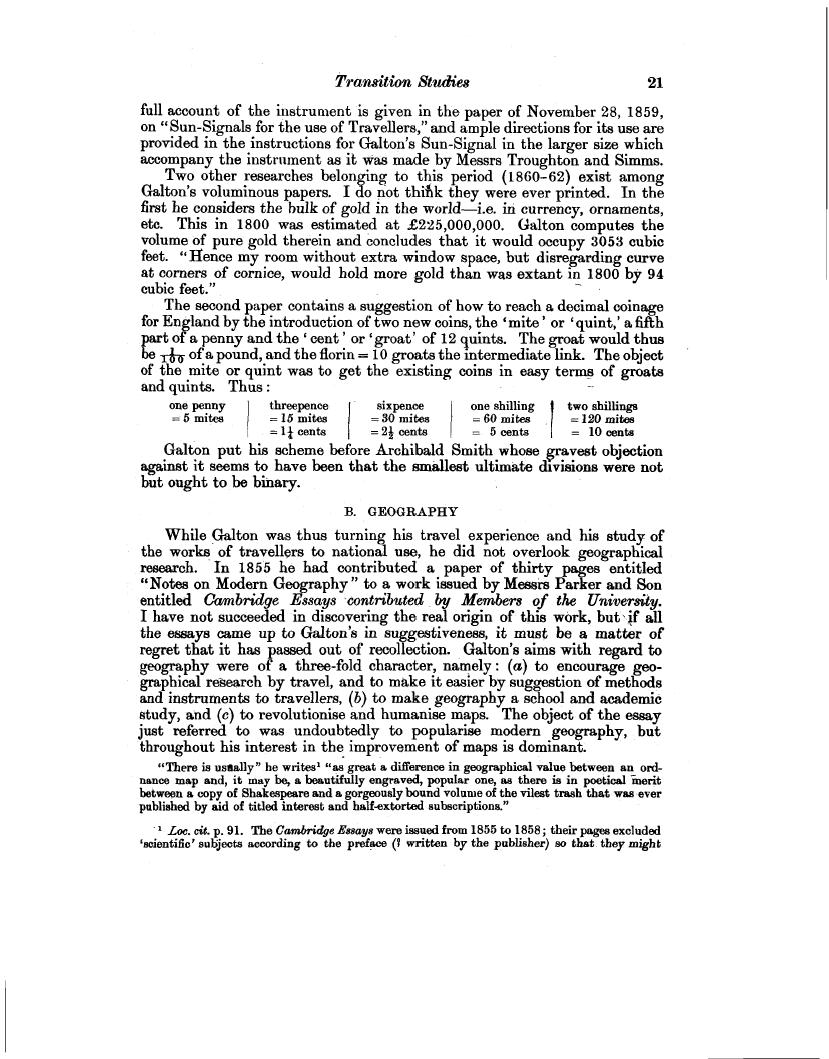Transition Studies 21
full account of the instrument is given in the paper of November 28, 1859, on "Sun-Signals for the use of Travellers," and ample directions for its use are provided in the instructions for Galton's Sun-Signal in the larger size which accompany the instrument as it was made by Messrs Troughton and Simms.
Two other researches belonging to this period (1860-62) exist among Galton's voluminous papers. I do not thibk they were ever printed. In the first be considers the bulk of gold in the world-i.e. in currency, ornaments, etc. This in 1800 was estimated at £225,000,000. Galton computes the volume of pure gold therein and concludes that it would occupy 3053 cubic feet. "Hence my room without extra window space, but disregarding curve at corners of cornice, would hold more gold than was extant in 1800 by 94 cubic feet."
The second paper contains a suggestion of how to reach a decimal coinage for England by the introduction of two new coins, the `mite' or `quint,' a fifth part of a penny and the 'cent' or ' groat' of 12 quints. The groat would thus be -rh of a pound, and the florin = 10 groats the intermediate link. The object of the mite or quint was to get the existing coins in easy terms of groats and quints. Thus
one penny = 5 mites
threepence sixpence =15 mites = 30 mites
=1 J cents = 2 1 cents
one shilling two shillings
= 60 mites =120 mites
5 cents = 10 cents
Galton put his scheme before Archibald Smith whose gravest objection against it seems to have been that the smallest ultimate divisions were not but ought to be binary.
B. GEOGRAPHY
While Galton was thus turning his travel experience and his study of the works of travellers to national use, he did not overlook geographical research. In 1855 he had contributed a paper of thirty pages entitled "Notes on Modern Geography" to a work issued by Messrs Parker and Son entitled Cambridge Essays contributed _ by Members of the University. I have not succeeded in discovering the real origin of this work, but, •if all the essays came up to Galton's in suggestiveness, it must be a matter of regret that it has passed out of recollection. Galton's aims with regard to geography were of a three-fold character, namely : (a) to encourage geographical research by travel, and to make it easier by suggestion of methods and instruments to travellers, (b) to make geography a school and academic study, and (c) to revolutionise and humanise maps. The object of the essay just referred to was undoubtedly to popularise modern geography, but throughout his interest in the improvement of maps is dominant.
"There is usually" he writes' "as great a difference in geographical value between an ordnance map and, it may be, a beautifully engraved, popular one, as there is in poetical merit between a copy of Shakespeare and a gorgeously bound volume of the vilest trash that was ever published by aid of titled interest and half-extorted subscriptions."
.' Loc. cit. p. 91. The Cambridge Essays were issued from 1855 to 1858; their pages excluded `scientific' subjects according to the preface (I written by the publisher) so that they might

